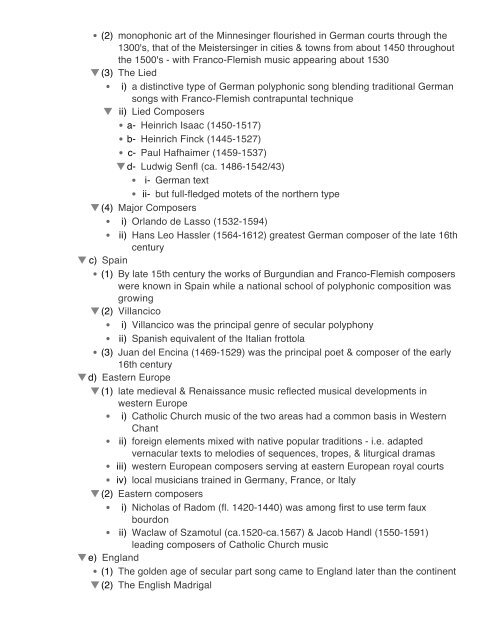An Outline of The History of Western Music Grout ... - The Reel Score
An Outline of The History of Western Music Grout ... - The Reel Score
An Outline of The History of Western Music Grout ... - The Reel Score
You also want an ePaper? Increase the reach of your titles
YUMPU automatically turns print PDFs into web optimized ePapers that Google loves.
(2) monophonic art <strong>of</strong> the Minnesinger flourished in German courts through the<br />
1300's, that <strong>of</strong> the Meistersinger in cities & towns from about 1450 throughout<br />
the 1500's - with Franco-Flemish music appearing about 1530<br />
(3) <strong>The</strong> Lied<br />
i) a distinctive type <strong>of</strong> German polyphonic song blending traditional German<br />
songs with Franco-Flemish contrapuntal technique<br />
ii) Lied Composers<br />
a- Heinrich Isaac (1450-1517)<br />
b- Heinrich Finck (1445-1527)<br />
c- Paul Hafhaimer (1459-1537)<br />
d- Ludwig Senfl (ca. 1486-1542/43)<br />
i- German text<br />
ii- but full-fledged motets <strong>of</strong> the northern type<br />
(4) Major Composers<br />
i) Orlando de Lasso (1532-1594)<br />
ii) Hans Leo Hassler (1564-1612) greatest German composer <strong>of</strong> the late 16th<br />
century<br />
c) Spain<br />
(1) By late 15th century the works <strong>of</strong> Burgundian and Franco-Flemish composers<br />
were known in Spain while a national school <strong>of</strong> polyphonic composition was<br />
growing<br />
(2) Villancico<br />
i) Villancico was the principal genre <strong>of</strong> secular polyphony<br />
ii) Spanish equivalent <strong>of</strong> the Italian frottola<br />
(3) Juan del Encina (1469-1529) was the principal poet & composer <strong>of</strong> the early<br />
16th century<br />
d) Eastern Europe<br />
(1) late medieval & Renaissance music reflected musical developments in<br />
western Europe<br />
i) Catholic Church music <strong>of</strong> the two areas had a common basis in <strong>Western</strong><br />
Chant<br />
ii) foreign elements mixed with native popular traditions - i.e. adapted<br />
vernacular texts to melodies <strong>of</strong> sequences, tropes, & liturgical dramas<br />
iii) western European composers serving at eastern European royal courts<br />
iv) local musicians trained in Germany, France, or Italy<br />
(2) Eastern composers<br />
i) Nicholas <strong>of</strong> Radom (fl. 1420-1440) was among first to use term faux<br />
bourdon<br />
ii) Waclaw <strong>of</strong> Szamotul (ca.1520-ca.1567) & Jacob Handl (1550-1591)<br />
leading composers <strong>of</strong> Catholic Church music<br />
e) England<br />
(1) <strong>The</strong> golden age <strong>of</strong> secular part song came to England later than the continent<br />
(2) <strong>The</strong> English Madrigal





